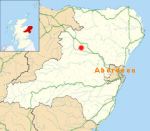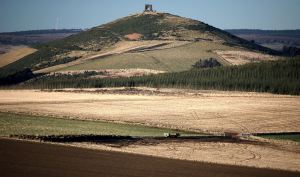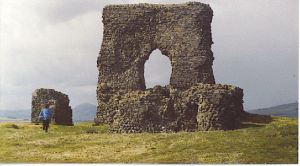Today, I’m out with my FOCUS Craft Fair group at an Aberdeenshire town named Insch (Scottish Gaelic: An Innis or Innis Mo Bheathain), about 14 miles North West of my home.
The Gaelic name for Insch really appeals to me, especially the Bheathain part, because one of the minor characters in my Celtic Fervour Series is named Beathan. Beathan means ‘lives by a clear stream’ and when writing Book 1, I also found a reference to it meaning ‘one with a great future’. That sounded like a perfect name for a child who had been predicted by Nara’s (my main female lead character) druid bretheren to be one who would, in the future, be a leader of the tribes. Back in 2011, I chose to simplify the spelling hoping to make it easier for my readers- but now I’m not so sure I should have.
Beathan is in Book 4 of my series (currently being written/that’s still an ‘oh, dear’ moment…) and, according to my long term plan, he will be the major character in the last planned book of the series – Book 5. (BTW- I might have to give up all of my daily pursuits to accomplish this! )
But back to Insch (pronounced IN SH). Today is the first time I’ve visited Insch to sell my novels and like all of the new venues that I’ve visited during the last year, I’ve learned a little about the place I’m visiting. Though it’s only a small town of just over 2 thousand inhabitants, it’s on the train line between the main cities of Aberdeen and Inverness. That might not seem like earth shattering information but most Aberdeenshire towns and villages don’t have a direct train link.
I’ve driven past Insch many times on the way to Inverness and have always admired the imposing structure that’s up on the nearby hillside. From a distance it resembles a whimsical folly, but it’s not- it’s a lot more than that.
(https://c4.staticflickr.com/4/3409/3197979866_093616fb35_b.jpg)
The Hill of Dunnideer (locally also spelled as Dunnydeer) was the site of an ancient rectangular hillfort, thought to be of the Middle Iron Age (possibly 350-190 BC), though dating of it is uncertain. As with many of the other high hills around Aberdeenshire, the view from the top of Dunnideer is spectacular. It’s easy for me to imagine how those ancient inhabitants of the hillfort observed what was going on in the valleys below them as they peered over the high walled ramparts. It’s not too far a stretch of the imagination to envisage a system of ‘fire’ signals going on between the high hillforts which were dotted around, the flares alerting the tribespeople of the Garioch area to any substantial threat to their livelihood – like the huge hazard of the Ancient Roman invaders I write about in my Celtic Fervour Series and in The Taexali Game, my time travel novel for teens. As a centre of power, religious or secular, its stone walls would have been very impressive.
There’s almost nothing left of the structure of that ancient hillfort. though some of the stones from its walled enclosure were used many centuries later to build what we can see today. What’s still visible now is the arch of a pointed medieval window, which originally gave light to a first floor hall of a rectangular tower house. When intact the tower house must have been a sight to see towering even higher over the landscape than the hillfort would have done, and was possibly very threatening to what would have been a very simple rural agrarian community working the foothills below. it would have stamped the ‘serfdom’ status on the people of the land as few other things would have done. it wouldn’t have seemed that the overlord was an ‘out of sight- out of mind’ ruler. His tower house was definitely ‘in their face’ and would have been a daily reminder of who was boss.
The building was first mentioned in writing as the stronghold of Sir John de Balliol in 1260, though is likely to be much older than that. Possibly the earliest tower house of its kind in Scotland, one of the walls has been known as Gregory’s Wall and it may have been built by Gregory the Great in AD 890. If not by Gregory, it could have been constructed by order of David, Earl of Huntingdon and Garioch in 1178. This David became King David I of Scotland.
The following sites give more information on him, some of which may expalin why he was possibly the one to commission the building of the tower house.
http://www.britroyals.com/scots.asp?id=david1
http://www.bbc.co.uk/history/historic_figures/david_i.shtml
What’s also unusual about the remains at Dunnideer tower house (sometimes called Dunnideer Castle) is that the granite blocks used to build it had been vitrified. A vitrified hillfort was one where extreme heat caused a fusion of the stones and some form of integrated wood, the continued conflagration melding the whole together. Charcoal deposits left from the vitification process have been used for the carbon dating- which resulted in the ‘B.C.’ dates.
This vitrification process, i.e. adding such extreme heat on purpose is not well understood yet. The reason for it remains unclear, though archaeologists don’t believe the ‘heat’ process was done to strengthen the building during construction. One theory is that vitrification took place after a deliberate destruction of the stronghold, either because it was under threat from an enemy, or because the structure was no longer needed for its original use. Some theories indicate that the hillforts like Dunnideer were not built for protection reasons but were perhaps religious or spiritual centres and that the eventual destruction may have been due to a change in the belief system, or because the site was no longer used for the same sacred purposes.
Wouldn’t it be lovely to know who lived there and why? Does anyone reading this have any theories they’d like to share on what the hillfort’s purpose was?
I’ll be thinking about it as I drive past…and I’ll also be composing an approx 100 word advertising pitch for my forthcoming radio advertising slot having had a successful interview last Wednesday. I’m doing the voice-over myself so I’ll probably be practising out loud in the car!
Meanwhile, have a lovely weekend, everyone.
http://www.themodernantiquarian.com/site/3246/dunnideer.html
 Nancy Jardine writes historical romantic adventures (Celtic Fervour Series); contemporary mystery thrillers (Take Me Now, Monogamy Twist, Topaz Eyes-finalist for THE PEOPLE’S BOOK PRIZE 2014)
Nancy Jardine writes historical romantic adventures (Celtic Fervour Series); contemporary mystery thrillers (Take Me Now, Monogamy Twist, Topaz Eyes-finalist for THE PEOPLE’S BOOK PRIZE 2014)
 & time-travel historical adventures for Teen/ YA readers (Rubidium Time Travel Series).
& time-travel historical adventures for Teen/ YA readers (Rubidium Time Travel Series).
Find her at: http://nancyjardine.blogspot.co.uk http://nancyjardineauthor.com/ Twitter @nansjar Facebook: http://on.fb.me/XeQdkG and http://on.fb.me/1Kaeh5G (for The Rubidium time Travel Novels.) email: nan_jar@btinternet.com
Amazon Author page for books and to view book trailer videos: http://viewauthor.at/mybooksandnewspagehere
Most novels are available in print and in ebook formats from Amazon; KOBO; Barnes and Noble; W. H. Smith.com; Waterstones.com; Smashwords; Blinkboxbooks; and various other ebook stores.





What a busy and successful lady you are! And I really enjoyed your post. I love history and especially history with a mystery, even though I’m frustrated when I don’t know the full story. What a fascinating spot. Good luck today and thanks for sharing a vision of the scenery you are passing.
LikeLiked by 1 person
Thank you, Neva. I’m back home now. This morning was seriously heavy rain and very low mist till about midday when it cleared a little. I could see no scenery on the way but it was beautiful on the way back. Sadly, I forgot my proper camera and the photos from my phone were too far away to see Dunnideer properly.
LikeLiked by 1 person
I am struggling to come up with a legitimate suggestion for you on the ‘why’ for hill forts. I liked the initial idea of a defensive fort to observe enemy movements, especially Roman invaders. But then when you mentioned religious reasons, that got me to thinking. I remember reading that Middle Eastern religions of ancient times thought their gods frequented mountaintops. That was true even for the initial beliefs of Israelites. And think about the idea of the Greek gods making their homes on Mount Olympus. So maybe these ancient folks were building temple like structure on the hilltops, not forts. Ultimately, we’ll going to have to find additional archeological evidence that will provide a more solid answer. I enjoyed your historical post.
LikeLike
Thanks, Mike. There’s not enough excavation been done yet on these hillforts (some in the pipeline locally, though) I favour the idea of the religious connections since the people seemed to have been small rural family groups, and only in later eras, merged into small communities of a cluster of roundhouses rather than single ones.
LikeLiked by 1 person
Love this post, Nancy. I enjoy historical facts and information and I’ll definitely be checking out the links. Good luck with the fair – hope you sell tons of books!
LikeLiked by 1 person
Hello, Linda! It was a good one. I sold 18 books and had a lovely conversation with 3 people who had listened to my radio interview. So, I was a happy lady on the drive home.
LikeLiked by 1 person
I hope you did well in selling your books. I do want to someday spend some time in Scotland. You talk about trotting about the countryside like we would go from one little town to another. Cher’ley
LikeLike
LOL Cher’ley! We do have a lot of countryside in between our little villages and small towns. It was my second best day for selling books , so far so, yes a very good day. The Church hall was filled with lots of lovely people.
LikeLike
Good. That’s how a lot of Florida is, you go from one town to the next without anything in between. The only way you know you have left one and entered another is the signs. Cher’ley
LikeLike
That is the most fascinating story. I love ancient places and the stories that might have taken place there. I’m going to ponder this for some time to come. Thanks for sharing Doris
LikeLike
There are so many ancient imponderables around here, Doris. So many monuments which don’t have a ‘real’ story, yet. Many of these sights will never get proper archaeological attention (no money) yet the people of the last couple of thousand years who lived in the area largely left them alone to deteriorate… and the ‘why’ of that’s also interesting.
LikeLike
Your country is so filled with history and how wonderful many ruins and places remain — makes for theorizing and story telling. I’m so glad you have a wonderful response to your books and the radio interview — isn’t connecting with readers, and potential readers, just so much fun??!! Congratulations on all your success, Nancy, and hope for more to come! 🙂
LikeLike
Thank you, Gayle- You’re so supportive and it’s much appreciated. My country is full of very ancient (many of which are still not understood) remains. I do the Craft Fairs because I love to connect with potential readers.
LikeLike
Fascinating post Nancy. Love learning stuff like this. You live in such a history-rich area.
Hope you had a successful time.
LikeLike
Thanks, Kate. I’m sharing my country’s history but I also love to learn what the Wranglers share about the north American continent! We can all learn a lot about the world around us…and what was.
LikeLike
What fascinating history tidbits. And congrats on the successful radio interview. Hope you had a good time at the fair and sold lots of books. You sure do get yourself and your work out there which I admire!
LikeLike
Thanks, Sarah. What with my few days a week grandkid minding, it’s all a bit exhausting but I’m getting there. 🙂
LikeLike
The mysteries of what once was and the why. I wonder if the ghosts of the ancient Celts face palm themselves when they hear theories about why their building were built. (No it was our meteorological center.)
LikeLike
You got it in one, Travis. What no doubt seemed perfectly natural to them is a subject of great controversy to us.
LikeLike
I am always fascinated by your posts on the historical sites around your country. I just find them so mysterious and romantic. I hope so deeply I get to visit Scotland and Ireland before I die.
LikeLike
Thank you, Joe. My country has a very ancient background indeed, but so has yours and I want to see a lot more of the US and Canada as well.
LikeLike
Thank you for sharing. I enjoyed touring the area through your eyes.
LikeLike